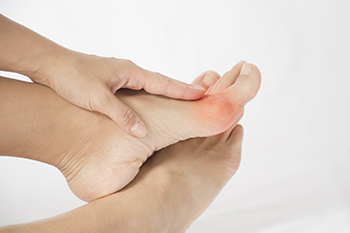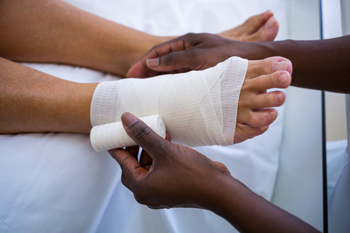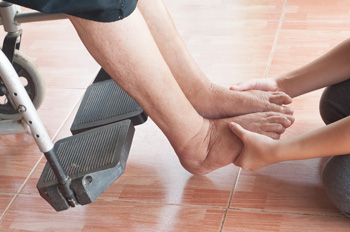Items filtered by date: December 2021
Signs and Symptoms of Claw Toes
If trying on shoes isn’t as much fun as it used to be, it may be caused by the development of hammertoes, also known as claw toes. This condition is recognizable by an unsightly bump on the knuckle of the toe, which can rub against the top of your shoe and cause pain. Claw toes can also affect the tip of the toe as it curls under and rubs against the sole of your shoe. They can cause the ball of the foot to become painful, a feeling sometimes described as walking on marbles. Claw toes can be caused by a muscle imbalance, where the long muscles in the leg overpower the smaller foot muscles. Other causes include injury to a tendon, tight calf muscles, and family history. The four lesser toes often develop claw toes, with the second toe the most likely to be affected. Home treatments include wearing shoes with a wider and deeper toe box to relieve rubbing, toe spacers and hammertoe splints, and soft padding to cushion the affected toes. However, if these measures fail to reduce your pain and discomfort, it is suggested that you contact a podiatrist to determine a more advanced course of treatment.
Hammertoe
Hammertoes can be a painful condition to live with. For more information, contact Elliot T. Udell, DPM from New York. Our doctor will answer any of your foot- and ankle-related questions.
Hammertoe is a foot deformity that affects the joints of the second, third, fourth, or fifth toes of your feet. It is a painful foot condition in which these toes curl and arch up, which can often lead to pain when wearing footwear.
Symptoms
- Pain in the affected toes
- Development of corns or calluses due to friction
- Inflammation
- Redness
- Contracture of the toes
Causes
Genetics – People who are genetically predisposed to hammertoe are often more susceptible
Arthritis – Because arthritis affects the joints in your toes, further deformities stemming from arthritis can occur
Trauma – Direct trauma to the toes could potentially lead to hammertoe
Ill-fitting shoes – Undue pressure on the front of the toes from ill-fitting shoes can potentially lead to the development of hammertoe
Treatment
Orthotics – Custom made inserts can be used to help relieve pressure placed on the toes and therefore relieve some of the pain associated with it
Medications – Oral medications such as anti-inflammatories or NSAIDs could be used to treat the pain and inflammation hammertoes causes. Injections of corticosteroids are also sometimes used
Surgery – In more severe cases where the hammertoes have become more rigid, foot surgery is a potential option
If you have any questions please contact our office located in Hicksville, NY . We offer the newest diagnostic and treatment technologies for all your foot and ankle needs.
When the Wound on Your Foot Becomes an Ulcer
Wounds can occur on the feet from an injury, poor circulation, prolonged pressure from improperly fitted shoes, or complications from diseases like diabetes, neuropathy, and vascular disease. Over time, if these wounds do not close and the underlying tissue becomes affected, they are considered ulcers. These types of wounds are potentially dangerous – particularly in people with diabetes. Ulcers can lead to infections in the bone and skin. You can sometimes tell if the wound on your foot has become an ulcer if it is draining, emits a foul odor, or the tissue has become thickened, inflamed, or red. It is important to seek the professional wound care that a podiatrist can provide to help heal the wound and prevent more serious complications from developing. Podiatrists typically begin by cleaning the wound and removing any unhealthy tissue, termed debridement. Antibiotics may be prescribed if an infection is present. They may also suggest certain shoes and orthotics that will keep pressure off the wound and, in severe cases, perform surgery and other methods of wound care.
Wound care is an important part in dealing with diabetes. If you have diabetes and a foot wound or would like more information about wound care for diabetics, consult with Elliot T. Udell, DPM from New York. Our doctor will assess your condition and provide you with quality foot and ankle treatment.
What Is Wound Care?
Wound care is the practice of taking proper care of a wound. This can range from the smallest to the largest of wounds. While everyone can benefit from proper wound care, it is much more important for diabetics. Diabetics often suffer from poor blood circulation which causes wounds to heal much slower than they would in a non-diabetic.
What Is the Importance of Wound Care?
While it may not seem apparent with small ulcers on the foot, for diabetics, any size ulcer can become infected. Diabetics often also suffer from neuropathy, or nerve loss. This means they might not even feel when they have an ulcer on their foot. If the wound becomes severely infected, amputation may be necessary. Therefore, it is of the upmost importance to properly care for any and all foot wounds.
How to Care for Wounds
The best way to care for foot wounds is to prevent them. For diabetics, this means daily inspections of the feet for any signs of abnormalities or ulcers. It is also recommended to see a podiatrist several times a year for a foot inspection. If you do have an ulcer, run the wound under water to clear dirt from the wound; then apply antibiotic ointment to the wound and cover with a bandage. Bandages should be changed daily and keeping pressure off the wound is smart. It is advised to see a podiatrist, who can keep an eye on it.
If you have any questions, please feel free to contact our office located in Hicksville, NY . We offer the newest diagnostic and treatment technologies for all your foot care needs.
Who Is Most at Risk for Age-Related Foot Problems?
Aging is a natural risk factor for many foot problems, including bunions, corns, calluses, hammertoes, ingrown toenails, fungal infections, diabetic foot problems, arthritis, heel pain, tarsal tunnel syndrome, and more. This is because as you age, your feet tend to spread and lose the fatty padding that cushions them. People with certain underlying medical conditions such as diabetes, arthritis, neuropathy, and congenital foot deformities may be more likely to develop foot problems. Specific lifestyle factors like wearing ill-fitting shoes, standing for prolonged periods of time, walking on hard surfaces, and being overweight can all contribute to the risk of foot problems. While medical risk factors are often outside of one’s control, lifestyle factors can usually be modified to prevent potential foot issues. For more information about aging and foot health, it is suggested that you consult with a podiatrist.
If you need your feet checked, contact Elliot T. Udell, DPM of New York. Our doctor will attend to all of your foot and ankle needs and provide you with quality treatment.
Geriatrics and Podiatry
When people age, some common issues that may occur are bone density loss, dry skin, poor circulation, and rough brittle nails. These issues may also affect your foot health if the necessary steps are not taken to alleviate the problems.
It is important to take care of your feet because feet that are injured or diseased can affect your overall health. Having painful feet hinders your ability to do daily activities or may decrease your willingness to do the things that you need to do.
Visiting Your Geriatrician
As we age, health problems become more likely, so it is essential to visit your doctor for check-ups to ensure that you are doing the best you can to take care of your health. It is recommended to check your feet frequently for any possible cuts, bruises, swelling, corns or any other irregularities.
Taking Care of Elderly Feet
Cracked or dry feet can be treated by applying moisturizer often. It is also important not to wear old socks because the older the sock is, the higher the possibility there will be that there is bacteria there. Wear fresh socks and make sure they fit properly.
Proper foot health means that you can have a more active lifestyle and you will not be bogged down by pain. Foot health also leads to good circulation, which is paramount for overall health.
If you have any questions, please feel free to contact our office located in Hicksville, NY . We offer the newest diagnostic tools and technology to treat your foot and ankle needs.
Should I Treat My Bunions?
 A bunion is a bony outgrowth that can develop at the base of the big toe joint. This is a type of foot deformity and can be painful. The skin around the bunion may become red, inflamed, thickened, and callused. Your big toe may begin to push on your second toe and point towards the little toes instead of straight ahead. Your big toe joint can even become stiff and difficult to move. Since bunions tend to worsen with time, seeking treatment is strongly suggested. In its early stages, a bunion can be treated by wearing wider, padded shoes or orthotic devices. Bunions that have progressed may need to be treated surgically. If you have painful bunions, please seek the care of a podiatrist.
A bunion is a bony outgrowth that can develop at the base of the big toe joint. This is a type of foot deformity and can be painful. The skin around the bunion may become red, inflamed, thickened, and callused. Your big toe may begin to push on your second toe and point towards the little toes instead of straight ahead. Your big toe joint can even become stiff and difficult to move. Since bunions tend to worsen with time, seeking treatment is strongly suggested. In its early stages, a bunion can be treated by wearing wider, padded shoes or orthotic devices. Bunions that have progressed may need to be treated surgically. If you have painful bunions, please seek the care of a podiatrist.
If you are suffering from bunion pain, contact Elliot T. Udell, DPM of New York. Our doctor can provide the care you need to keep you pain-free and on your feet.
What Is a Bunion?
Bunions are painful bony bumps that usually develop on the inside of the foot at the joint of the big toe. As the deformity increases over time, it may become painful to walk and wear shoes. Women are more likely to exacerbate existing bunions since they often wear tight, narrow shoes that shift their toes together. Bunion pain can be relieved by wearing wider shoes with enough room for the toes.
Causes
- Genetics – some people inherit feet that are more prone to bunion development
- Inflammatory Conditions - rheumatoid arthritis and polio may cause bunion development
Symptoms
- Redness and inflammation
- Pain and tenderness
- Callus or corns on the bump
- Restricted motion in the big toe
In order to diagnose your bunion, your podiatrist may ask about your medical history, symptoms, and general health. Your doctor might also order an x-ray to take a closer look at your feet. Nonsurgical treatment options include orthotics, padding, icing, changes in footwear, and medication. If nonsurgical treatments don’t alleviate your bunion pain, surgery may be necessary.
If you have any questions, please feel free to contact our office located in Hicksville, NY . We offer the newest diagnostic and treatment technologies for all your foot care needs.




